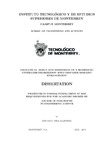| dc.contributor.advisor | Rodriguez-Leal, Ernesto | |
| dc.creator | Piña-Martínez, Eduardo | |
| dc.creator | https://orcid.org/0000-0002-4730-6870 | |
| dc.date.accessioned | 2019-08-29T23:33:07Z | |
| dc.date.available | 2019-08-29T23:33:07Z | |
| dc.date.created | 2019-05 | |
| dc.identifier.citation | E. Piña-Martínez (2019). Mechanical Design and Assessment of a Biomimetic Upper-Limb Exoskeleton with Shoulder Mobility Enhancement. | es_MX |
| dc.identifier.uri | http://hdl.handle.net/11285/633045 | |
| dc.description.abstract | Exoskeletons raise as the common ground between Robotics and Biomechanics, where rehabilitation is the main field in which these two disciplines find cohesion. Furthermore, the everlasting debate between the use of human labour or robotic machines could find a solution in these outstanding devices, which are intended to actuate in harmony with their wearers, maintaining the strength, precision, and accuracy commonly attributed to robots; and the dexterity, versatility, adaptability, and problem solving skills of human workers. To reach this point however, it becomes necessary to overcome the barriers that this robotic technology still has, such as the mechanical complexity that this devices demand.
One of the most relevant challenges in upper-limb exoskeleton design relies in the high complexity of the human shoulder, where current devices implement elaborate systems only to emulate the drifting center of rotation of the shoulder joint. The main goal of this thesis project is to develop an upper limb exoskeleton mechanism, with the ability to allow complete movement of its wearer. This work proposes the use of 3D scanning vision technologies to ease the design process and its implementation on a variety of subjects, while a motion tracking system based on vision technologies is applied to assess the exoskeleton reachable workspace compared with an asymptomatic subject. Furthermore, the anatomic fitting index is proposed, which compares the anatomic workspace of the user with the exoskeleton workspace and provides insight into its features. This work proposes an exoskeleton architecture that considers the clavicle motion over the coronal plane whose workspace is determined by substituting the direct kinematics model with the dimensional parameters of the user. Simulations and numerical examples are used to validate the analytical results and to conciliate the experimental results provided by the vision tracking system.
Moreover, this development is extended to the evaluation of the resulting prototype in tasks that depend on the users mobility freedom, where gross motion tracking was selected. The evaluation of this task is made by a real time comparison of the instrumented exoskeleton data and data obtained by a gross motion tracking commercial system, widely used in the state of the art developments and research works. Results from these design, development and assessment tasks show the proficiency of the proposed mechanism, reaching portability, mobility and lightness. | es_MX |
| dc.format.medium | Texto | es_MX |
| dc.publisher | Instituto Tecnológico y de Estudios Superiores de Monterrey | esp |
| dc.relation.isFormatOf | versión publicada | es_MX |
| dc.rights | Open Access | es_MX |
| dc.rights.uri | http://creativecommons.org/licenses/by-nc-nd/4.0/ | * |
| dc.subject | INGENIERÍA Y TECNOLOGÍA::CIENCIAS TECNOLÓGICAS::TECNOLOGÍA MÉDICA::PRÓTESIS | es_MX |
| dc.subject.lcsh | Ingeniería y Ciencias Aplicadas / Engineering & Applied Sciences | es_MX |
| dc.title | Mechanical Design and Assessment of a Biomimetic Upper-Limb Exoskeleton with Shoulder Mobility Enhancement | es_MX |
| dc.type | Tesis Doctorado / doctoral Thesis | es_MX |
| dc.contributor.committeemember | Roberts, Ricardo | |
| dc.contributor.committeemember | Gordillo Moscos, José Luis | |
| dc.contributor.committeemember | Garza Castañón, Luis Eduardo | |
| dc.contributor.committeemember | Soto Rodríguez, Rogelio | |
| dc.publisher.institution | Instituto Tecnológico y de Estudios Superiores de Monterrey | es_MX |
| dc.subject.keyword | Biomimetic | es_MX |
| dc.subject.keyword | Exoskeleton | es_MX |
| dc.subject.keyword | Upper-Limb | es_MX |
| dc.subject.keyword | Range of motion | es_MX |
| dc.subject.keyword | Performance | es_MX |
| dc.subject.keyword | Gross motion | es_MX |
| dc.subject.keyword | Mechanical design | es_MX |
| dc.contributor.institution | Campus Monterrey | es_MX |
| dc.contributor.institution | Campus Monterrey | es_MX |
| dc.contributor.institution | Campus Monterrey | es_MX |
| dc.description.degree | Doctorado en Ciencias de la Ingeniería | es_MX |
| dc.audience.educationlevel | Investigadores/Researchers | es_MX |
| dc.relation.impreso | 2019-05 | |



